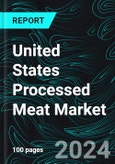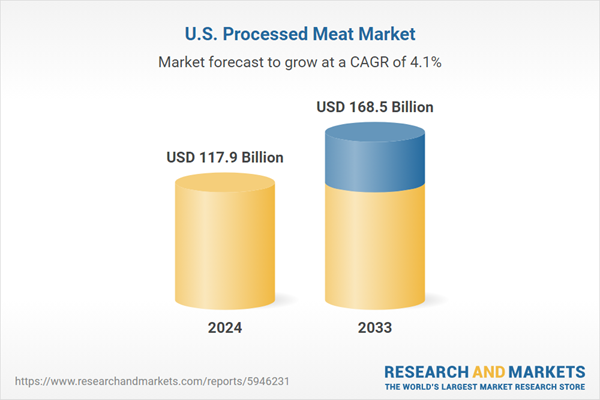United States Processed Meat market is expected to reach US$ 168.5 billion by 2033 from US$ 117.9 billion in 2024, with a CAGR of 4.05% from 2025 to 2033. Market sales are increased by elements including accessibility, price, ease of use, and palatable flavor. There are numerous variations of the same product and ongoing innovation in the processed meat sector. In the processed category, clean-label and all-natural products are still popular. Popular claims on labels for processed meat products include low-sodium, low-fat, low-calorie, no MSG, and free of additives and preservatives.
The report United States Processed Meat Market & Forecast covers by Meat Type (Poultry, Beef, Pork, Others), Processed Type (Frozen, Chilled, Canned), Distribution Channel (Hypermarkets and Supermarkets, Convenience Stores, Online Retail Stores) and Company Analysis 2025-2033.
United States Processed Meat Industry Overview
Meat that has been preserved by techniques like smoking, salting, fermenting, or adding chemicals to improve its flavor and shelf life is referred to as processed meat. Beef, hog, turkey, chicken, and lamb are frequently processed meats that are used to make sausages, jerky, pepperoni, and hot dogs. To stop bacteria and other microbes from causing these meats to expire, preservatives are applied. The market for processed meat is extensively used in institutional and retail contexts. Due to consumer preferences for shopping at supermarkets, hypermarkets, and online, retail sales are significant. Additionally, demand is driven by the food service business, specifically the HoReCa sector.
In order to meet the needs of animals for protein, vitamins, or minerals, forage-based diets are strategically supplemented by technology-driven meat manufacturers in the United States. With a nearly 30% market share in 2022, the US ranks among the world's top producers of beef. In 2022, the nation's beef production increased by 354.9 million pounds to 28.4 billion pounds. Missouri, Texas, Oklahoma, and Ohio are the leading beef-producing states in the United States. About 2.9 million cattle were killed in Ohio in 2022, making it one of the top beef-producing states in the country. Additionally, Ohio produced 2% more beef in 2022 than it did in 2021.
Additionally, Cargill Inc. acquired two meat facilities from longtime partner Ahold Delhaize USA in February 2024. To increase its production and supply merchants in the Northeast region of the nation with supermarket-case-ready beef and pork, the company has made investments in two processing facilities.
Growth Drivers for the United States Processed Meat Market
Rising Consumer Demand for Convenience
The market for processed meat in the United States is expanding due in large part to rising customer desire for convenience. Customers are looking for products that require little cooking time and rapid preparation because their lives are becoming more and more hectic. Processed meats that are ready to eat, such cold cuts, sausages, and deli meats, meet this need well and offer a convenient option for meals and snacks. Furthermore, frozen processed beef products are becoming more and more well-liked due to their extended shelf life and ease of meal preparation. The need for quick, easy food options has increased as more people work longer hours and value convenience. As a result of this change, processed meat sales have increased in supermarkets, convenience stores, and online marketplaces, bolstering the U.S. market's ongoing growth.
Increased Disposable Income
The US processed meat business is expanding as a result of customers' increased ability to spend more on high-end goods due to their increased disposable income. Consumers are willing to spend more for premium processed meats, like organic, grass-fed, and gourmet varieties, when family earnings improve. Consumer desires for quality and transparency in food sources are expanding, and these high-end items are perceived as healthier, more sustainable, and better tasting. Additionally, consumers are more likely to experiment with specialized meats like premium cuts, cured meats, and artisanal sausages as their discretionary income increases. This tendency is especially prevalent among wealthy, health-conscious consumers who are prepared to spend money on high-end foods, which is driving up demand for upscale processed beef products and opening up new markets.
Demand from Food Service Industry
One of the main factors propelling the processed meat market in the United States is the expanding demand from the food service sector. Processed meats are widely employed in a variety of menu items, such as sandwiches, burgers, wraps, salads, and breakfast options, as the fast-food and restaurant industries continue to grow. Popular processed meats including deli meats, bacon, sausage, and ham are used extensively in quick-service and fast-casual restaurants since they are essential to many restaurant recipes. Additionally, because processed meats are simple to handle, store, and cook in big numbers, the growing popularity of delivery and takeout services has increased the use of processed meats. The food service industry's increasing reliance on processed meats fosters market expansion and opens up new business prospects for producers.
Challenges in the United States Processed Meat Market
Intense Competition
The increased popularity of plant-based meat substitutes is a major factor driving the fierce competition in the US processed meat sector. Customers who are worried about the health hazards of processed meats, such as their high sodium content, preservatives, and saturated fats, are drawn to these substitutes, which are frequently promoted as better and more ecologically friendly options. Products derived from plants, such as soy, pea protein, and mushrooms, are thought to address these issues and satisfy consumers' growing need for cruelty-free and sustainable food sources. In order to stand out from the competition and hold onto market share, traditional processed meat companies are under pressure to innovate, whether through cleaner labels, healthier formulations, or new product offers. In order to remain competitive in a changing market, meat producers are being forced to reconsider their tactics due to the trend toward plant-based diets.
Beef's popularity and versatility may drive dominance in processed meats
Beef could be a dominant meat type in the U.S. processed meat market. This is because of its enormous reputation and adaptable utilization. With a wealthy flavor profile and diverse applications, beef merchandise attracts a broad purchaser base. Its adaptability in various processed meat forms, such as sausages, burgers, and deli meats, makes it a staple in American diets. Further, the established beef enterprise infrastructure ensures steady supply and quality, further solidifying beef's prominent role in the United States processed meat market.
Chilled processed meat's freshness and convenience may lead market dominance
Chilled processed meat holds the potential for the largest share of the United States processed meat. This is because of its freshness, enchantment, and convenience. With purchasers increasingly prioritizing convenience without compromising quality, chilled processed meat products provide stability in shelf life and freshness. These merchandises undergo minimal processing, retaining natural flavors and textures, which resonates nicely with health-aware consumers. Further, the extensive availability of refrigeration infrastructure guarantees the accessibility and preservation of chilled processed meat. This is contributing to its dominance in the U.S. processed meat market.
Hypermarkets and supermarkets drive significant sales in the processed meat market
Hypermarkets and supermarkets are among the leading sections of the United States processed meat market. This is because of their massive reach and various product offerings. These retail giants offer a wide selection of processed meat products under one roof, imparting comfort and range to purchasers. Also, their strategic locations and efficient supply chain control ensure regular availability and competitive pricing. The extensive client base and promotional activities further bolster their dominance, making hypermarkets and supermarkets the preferred destination for processed meat purchases in the U.S.
United States Processed Meat Market Segments
Meat Type - Market breakup in 4 viewpoints:
1. Poultry
2. Beef
3. Pork
4. Others
Processed Type - Market breakup in 3 viewpoints:
1. Frozen
2. Chilled
3. Canned
Distribution Channel - Market breakup in 4 viewpoints:
1. Hypermarkets and Supermarkets
2. Convenience Stores
3. Online Retail Stores
4. Others
All the Key players have been covered from 3 Viewpoints:
- Overview
- Recent Development
- Revenue Analysis
Company Analysis:
1. Hormel Foods
2. Tyson Foods
3. Conagra Brands Inc.
4. General Mills
5. Kraft Heinz Company
6. Cargill, Incorporated,
7. Pilgrim’s Pride Corp.
Table of Contents
Companies Mentioned
- Hormel Foods
- Tyson Foods
- Conagra Brands Inc.
- General Mills
- Kraft Heinz Company
- Cargill, Incorporated,
- Pilgrim’s Pride Corp.
Methodology
In this report, for analyzing the future trends for the studied market during the forecast period, the publisher has incorporated rigorous statistical and econometric methods, further scrutinized by secondary, primary sources and by in-house experts, supported through their extensive data intelligence repository. The market is studied holistically from both demand and supply-side perspectives. This is carried out to analyze both end-user and producer behavior patterns, in the review period, which affects price, demand and consumption trends. As the study demands to analyze the long-term nature of the market, the identification of factors influencing the market is based on the fundamentality of the study market.
Through secondary and primary researches, which largely include interviews with industry participants, reliable statistics, and regional intelligence, are identified and are transformed to quantitative data through data extraction, and further applied for inferential purposes. The publisher's in-house industry experts play an instrumental role in designing analytic tools and models, tailored to the requirements of a particular industry segment. These analytical tools and models sanitize the data & statistics and enhance the accuracy of their recommendations and advice.
Primary Research
The primary purpose of this phase is to extract qualitative information regarding the market from the key industry leaders. The primary research efforts include reaching out to participants through mail, tele-conversations, referrals, professional networks, and face-to-face interactions. The publisher also established professional corporate relations with various companies that allow us greater flexibility for reaching out to industry participants and commentators for interviews and discussions, fulfilling the following functions:
- Validates and improves the data quality and strengthens research proceeds
- Further develop the analyst team’s market understanding and expertise
- Supplies authentic information about market size, share, growth, and forecast
The researcher's primary research interview and discussion panels are typically composed of the most experienced industry members. These participants include, however, are not limited to:
- Chief executives and VPs of leading corporations specific to the industry
- Product and sales managers or country heads; channel partners and top level distributors; banking, investment, and valuation experts
- Key opinion leaders (KOLs)
Secondary Research
The publisher refers to a broad array of industry sources for their secondary research, which typically includes, however, is not limited to:
- Company SEC filings, annual reports, company websites, broker & financial reports, and investor presentations for competitive scenario and shape of the industry
- Patent and regulatory databases for understanding of technical & legal developments
- Scientific and technical writings for product information and related preemptions
- Regional government and statistical databases for macro analysis
- Authentic new articles, webcasts, and other related releases for market evaluation
- Internal and external proprietary databases, key market indicators, and relevant press releases for market estimates and forecasts

LOADING...
Table Information
| Report Attribute | Details |
|---|---|
| No. of Pages | 70 |
| Published | February 2025 |
| Forecast Period | 2024 - 2033 |
| Estimated Market Value ( USD | $ 117.9 Billion |
| Forecasted Market Value ( USD | $ 168.5 Billion |
| Compound Annual Growth Rate | 4.0% |
| Regions Covered | United States |
| No. of Companies Mentioned | 7 |









